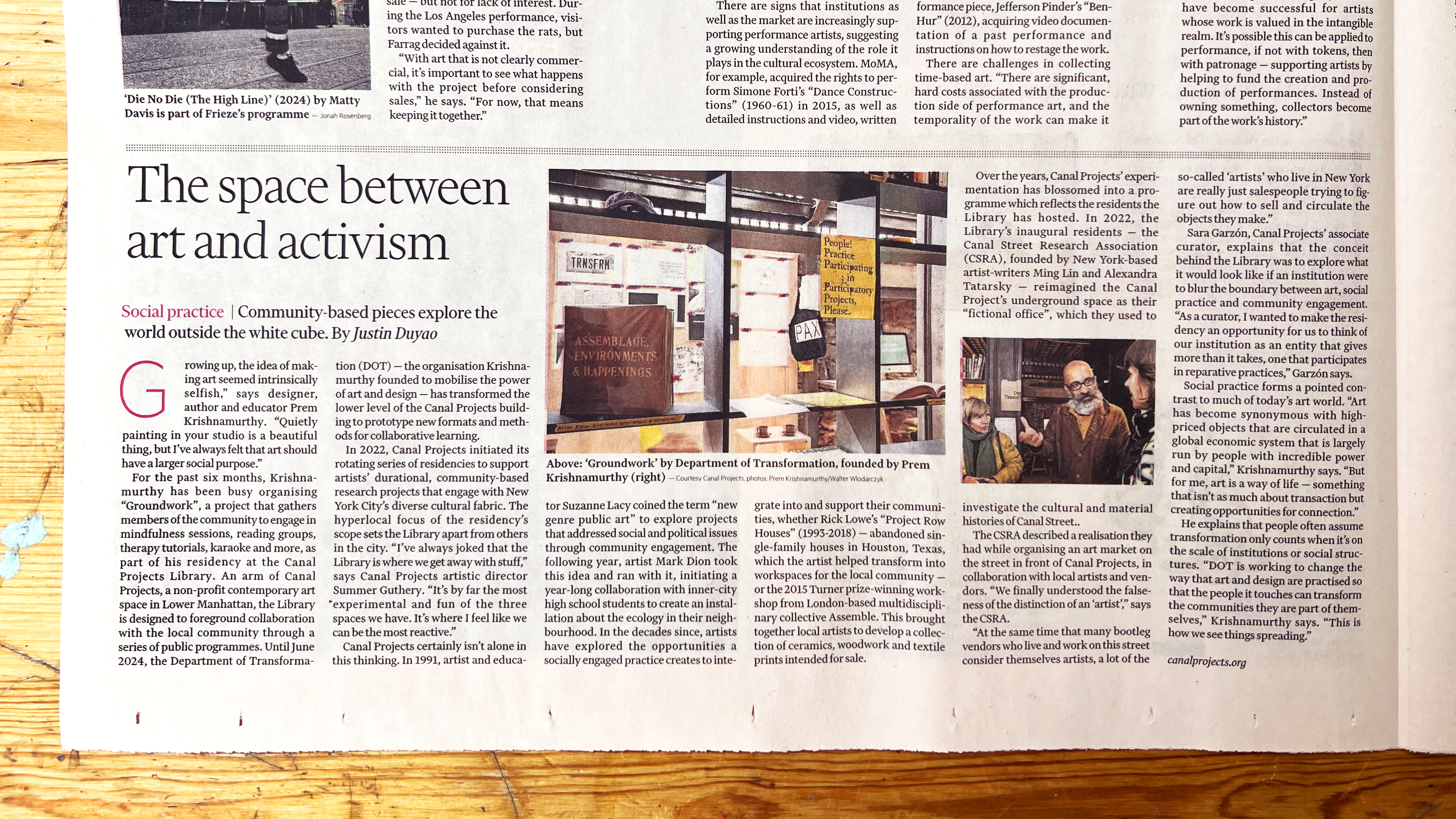by Justin Duyao, April 27, 2024
read online here

“Growing up, the idea of making art seemed intrinsically selfish,” says designer, author and educator Prem Krishnamurthy. “Quietly painting in your studio is a beautiful thing, but I’ve always felt that art should have a larger social purpose.”
For the past six months, Krishnamurthy has been busy organising “Groundwork”, a project that gathers members of the community to engage in mindfulness sessions, reading groups, therapy tutorials, karaoke and more, as part of his residency at the Canal Projects Library. An arm of Canal Projects, a non-profit contemporary art space in Lower Manhattan, the Library is designed to foreground collaboration with the local community through a series of public programmes. Until June 2024, the Department of Transformation (DOT) — the organisation Krishnamurthy founded to mobilise the power of art and design — has transformed the lower level of the Canal Projects building to prototype new formats and methods for collaborative learning.
In 2022, Canal Projects initiated its rotating series of residencies to support artists’ durational, community-based research projects that engage with New York City’s diverse cultural fabric. The hyperlocal focus of the residency’s scope sets the Library apart from others available in the city. “I’ve always joked that the Library is where we get away with stuff,” says Canal Projects artistic director Summer Guthery. “It’s by far the most experimental and fun of the three spaces we have. It’s where I feel like we can be the most reactive.”
Canal Projects certainly isn’t alone in this thinking. In 1991, artist and educator Suzanne Lacy coined the term “new genre public art” to explore projects that addressed social and political issues through community engagement. The following year, artist Mark Dion took this idea and ran with it, initiating a year-long collaboration with inner-city high school students to create an installation about the ecology in their neighbourhood.
In the decades that followed, countless artists have explored the opportunities a socially engaged practice creates to integrate into and support their communities, whether Rick Lowe’s “Project Row Houses” (1993-2018) — abandoned single-family houses in Houston, Texas, which the artist helped transform into workspaces for the local community — or the 2015 Turner prize-winning workshop from London-based multidisciplinary collective Assemble. This brought together local artists to develop a collection of ceramics, woodwork and textile prints intended for sale.
Over the years, Canal Projects’ experimentation has blossomed into a programme which reflects the residents the Library has hosted. In 2022, the Library’s inaugural residents — the Canal Street Research Association (CSRA), founded by New York-based artist-writers Ming Lin and Alexandra Tatarsky — reimagined the Canal Project’s underground space as their “fictional office”, which they used to investigate the cultural and material histories of Canal Street.
“We’re always interested in toeing the line between official and unofficial,” says the CSRA. “So even while the semifictional context of the Canal Projects Library isn’t, technically, a ‘public space’, we were still able to create opportunities to engage with the community in a fruitful way.”
The CSRA described a realisation they had while organising an art market on the street in front of Canal Projects, in collaboration with local artists and vendors. “We finally understood the falseness of the distinction of an ‘artist’,” says the CSRA. “At the same time that many bootleg vendors who live and work on this street consider themselves artists, a lot of the so-called ‘artists’ who live in New York are really just salespeople trying to figure out how to sell and circulate the objects they make.”
Sara Garzón, Canal Projects’ associate curator, explains that the conceit behind the Canal Projects Library was to explore what it would look like if an art institution were to blur the boundary between art, social practice and community engagement. “As a curator, I wanted to make the residency an opportunity for us to think of our institution as an entity that gives more than it takes, one that participates in reparative practices,” Garzón says. “After all, a library isn’t a studio space. It’s a community space.”
Social practice forms a pointed contrast to much of today’s art world. “Art has become synonymous with high-priced objects that are circulated in a global economic system that is largely run by people with incredible power and capital,” Krishnamurthy says. “But for me, art is a way of life — something that isn’t as much about transaction but creating opportunities for connection.”
He explains that people often assume transformation only counts when it’s on the scale of institutions or social structures. For him, it also happens in every conversation he has.
“DOT is working to change way that art and design are practiced so that the people it touches can transform the communities they are part of themselves,” Krishnamurthy says. “This is how we see things spreading.”